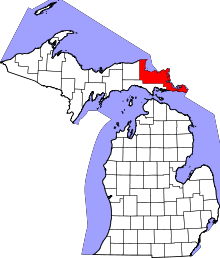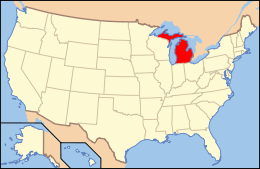Chippewa County, Michigan
| Chippewa County, Michigan | ||
|---|---|---|
 Chippewa County Courthouse, Sault Ste. Marie | ||
| ||
 Location in the U.S. state of Michigan | ||
 Michigan's location in the U.S. | ||
| Founded | December 22, 1826[1][2] | |
| Named for | Ojibwe people | |
| Seat | Sault Ste. Marie | |
| Largest city | Sault Ste. Marie | |
| Area | ||
| • Total | 2,698 sq mi (6,988 km2) | |
| • Land | 1,558 sq mi (4,035 km2) | |
| • Water | 1,140 sq mi (2,953 km2), 42% | |
| Population | ||
| • (2010) | 38,520 | |
| • Density | 25/sq mi (10/km²) | |
| Congressional district | 1st | |
| Time zone | Eastern: UTC-5/-4 | |
| Website |
www | |

Chippewa County is a county in the Upper Peninsula of the U.S. state of Michigan. As of the 2010 census, the population was 38,520.[3] The county seat is Sault Ste. Marie.[4] The county is named for the Chippewa tribe, and was set off and organized in 1826.[1]
Chippewa County comprises the Sault Ste. Marie, MI micropolitan statistical area.
Geography
According to the U.S. Census Bureau, the county has a total area of 2,698 square miles (6,990 km2), of which 1,558 square miles (4,040 km2) is land and 1,140 square miles (3,000 km2) (42%) is water.[5] It is the second-largest county in Michigan by land area and fifth-largest by total area.
The Michigan Meridian runs through the eastern portion of the county. South of Nine Mile Road, M-129 (Meridian Road) overlays the meridian. In Sault Ste. Marie, Meridian Street north of 12th Avenue overlays the meridian.
Adjacent counties
- Algoma District, Ontario, Canada (northeast)
- Manitoulin District, Ontario, Canada (east)
- Presque Isle County (southeast)
- Mackinac County (south)
- Luce County (west)
National protected areas
- Harbor Island National Wildlife Refuge
- Hiawatha National Forest (part)
- Whitefish Point Unit of the Seney National Wildlife Refuge
Game areas
The Munuscong Bay is open for recreation uses, such as hunting, boating and bird watching. The area is known for its duck hunting, including mallards, divers and green-winged teal ducks. The Bay is most known for its icefishing and duck hunting. During opening weekend of duck season (late September), hundreds of hunters come from all over the state to begin their season on the Bay. This area has many types of waterfowl pass through it each year on their southern and northern migrations.
Transportation
State highways
All Interstate and US Highways in Michigan, like all state-maintained highways, are part of the Michigan State Trunkline Highway System.
 I-73 (future)
I-73 (future) I-75 ends at the Sault Ste. Marie International Bridge at the Canada border.
I-75 ends at the Sault Ste. Marie International Bridge at the Canada border. M-28
M-28 M-48
M-48 M-80
M-80 M-123
M-123 M-129
M-129 M-134
M-134 M-221
M-221 BS I-75 travels from I-75 into downtown Sault Ste. Marie.
BS I-75 travels from I-75 into downtown Sault Ste. Marie.
County-designated highways
The following highways are maintained by the Chippewa County Road Commission as part of the county road system. They are assigned numbers by the Michigan Department of Transportation as part of the County-Designated Highway System.
 H-40
H-40 H-63 runs via Mackinac Trail, the former route of US 2 before it was replaced by I-75 in 1962.
H-63 runs via Mackinac Trail, the former route of US 2 before it was replaced by I-75 in 1962.
In addition, the county road commission jointly maintains Whitefish Bay National Forest Scenic Byway, a National Forest Scenic Byway with the US Forest Service.
Airports
Chippewa County International Airport (CIU) serves Chippewa county and the surrounding communities.
Drummond Island Airport (DRM) enhances county service.
Demographics
| Historical population | |||
|---|---|---|---|
| Census | Pop. | %± | |
| 1830 | 626 | — | |
| 1840 | 534 | −14.7% | |
| 1850 | 898 | 68.2% | |
| 1860 | 1,603 | 78.5% | |
| 1870 | 1,689 | 5.4% | |
| 1880 | 5,248 | 210.7% | |
| 1890 | 12,019 | 129.0% | |
| 1900 | 21,338 | 77.5% | |
| 1910 | 24,472 | 14.7% | |
| 1920 | 24,818 | 1.4% | |
| 1930 | 25,047 | 0.9% | |
| 1940 | 27,807 | 11.0% | |
| 1950 | 29,206 | 5.0% | |
| 1960 | 32,655 | 11.8% | |
| 1970 | 32,412 | −0.7% | |
| 1980 | 29,029 | −10.4% | |
| 1990 | 34,604 | 19.2% | |
| 2000 | 38,543 | 11.4% | |
| 2010 | 38,520 | −0.1% | |
| Est. 2015 | 38,033 | [6] | −1.3% |
| U.S. Decennial Census[7] 1790-1960[8] 1900-1990[9] 1990-2000[10] 2010-2013[3] | |||
The 2010 United States Census[11] indicates Chippewa County had a population of 38,520. This is a decrease of 23 people from the 2000 United States Census. This is a -0.1% change in population. In 2010 there were 14,329 households and 9,106 families in the county. The population density was 24.7 per square mile (9.5 square kilometers). There were 21,253 housing units at an average density of 13.6 per square mile (5.3 square kilometers). 72.3% of the population were White, 15.8% Native American, 6.5% Black or African American, 0.6% Asian, 0.1% Pacific Islander, 0.2% of some other race and 4.6% of two or more races. 1.2% were Hispanic or Latino (of any race). 17.0% were of German, 11.8% English, 12.2% Irish, 8.8% French, 6.4% Polish ancestry.[12]
There were 14,329 households out of which 28.2% had children under the age of 18 living with them, 47.5% were husband and wife families, 10.9% had a female householder with no husband present, 36.5% were non-families, and 29.5% were made up of individuals. The average household size was 2.34 and the average family size was 2.88.
In the county the population was spread out with 20.1% under age of 18, 11.0% from 18 to 24, 26.5% from 25 to 44, 27.7% from 45 to 64, and 14.6% who were 65 years of age or older. The median age was 40 years. The population was 55.1% male and 44.9% female.
The 2010 American Community Survey 3-year estimate[13] indicates the median income for a household in the county was $39,351 and the median income for a family was $54,625. Males had a median income of $25,760 versus $16,782 for females. The per capita income for the county was $19,334. About 2.3% of families and 18.6% of the population were below the poverty line, including 26.0% of those under the age 18 and 10.0% of those age 65 or over.
Government
The county government operates the jail, maintains rural roads, operates the major local courts, keeps files of deeds and mortgages, maintains vital records, administers public health regulations, and participates with the state in the provision of welfare and other social services. The county board of commissioners controls the budget but has only limited authority to make laws or ordinances. In Michigan, most local government functions — police and fire, building and zoning, tax assessment, street maintenance, etc. — are the responsibility of individual cities and townships.
Elected officials
- Prosecuting Attorney: Dennis J. McShane[14]
- Sheriff: Robert Savoie[15]
- County Clerk: Cathy Maleport[16]
- County Treasurer: Majorie Hank[17]
- Register of Deeds: Sharon Kennedy[18]
- Drain Commissioner: Anthony Bosley[19]
- County Surveyor: William Karr[20]
(information updated July, 2013)[21]
Communities
City
- Sault Ste. Marie (county seat)
Village
Unincorporated communities
Townships
See also
- Delirium Wilderness
- List of Michigan State Historic Sites in Chippewa County, Michigan
- National Register of Historic Places listings in Chippewa County, Michigan
References
- 1 2 "Bibliography on Chippewa County". Clarke Historical Library, Central Michigan University. Retrieved July 17, 2013.
- ↑ Chapman, C.H. (February 23, 1893). "Early History of Chippewa County: Lore of Old" (PDF). Lansing, Michigan: The News/Chippewa County Government. Retrieved February 25, 2013.
- 1 2 "State & County QuickFacts". United States Census Bureau. Retrieved August 27, 2013.
- ↑ "Find a County". National Association of Counties. Archived from the original on 2015-05-10. Retrieved 2011-06-07.
- ↑ "2010 Census Gazetteer Files". United States Census Bureau. August 22, 2012. Retrieved September 19, 2014.
- ↑ "County Totals Dataset: Population, Population Change and Estimated Components of Population Change: April 1, 2010 to July 1, 2015". Retrieved July 2, 2016.
- ↑ "U.S. Decennial Census". United States Census Bureau. Archived from the original on May 11, 2015. Retrieved September 19, 2014.
- ↑ "Historical Census Browser". University of Virginia Library. Retrieved September 19, 2014.
- ↑ "Population of Counties by Decennial Census: 1900 to 1990". United States Census Bureau. Retrieved September 19, 2014.
- ↑ "Census 2000 PHC-T-4. Ranking Tables for Counties: 1990 and 2000" (PDF). United States Census Bureau. Retrieved September 19, 2014.
- ↑ "Census 2010 American Fact Finder". Retrieved July 6, 2013.
- ↑ Data Access and Dissemination Systems (DADS). "American FactFinder". census.gov.
- ↑ "American Factfinder". United States Census Bureau. Retrieved March 11, 2012.
- ↑ "Chippewa County Prosecutor". Chippewa County. Retrieved 19 October 2015.
- ↑ "Chippewa County Department Sheriff's Office". Chippewa County. Retrieved 19 October 2015.
- ↑ "Chippewa County Clerk". Chippewa County. Retrieved 19 October 2015.
- ↑ "Chippewa County Treasurer". Chippewa County. Retrieved 19 October 2015.
- ↑ "Chippewa County Register of Deeds". Chippewa County. Retrieved 19 October 2015.
- ↑ "Chippewa County Drain Commissioner". Chippewa County. Retrieved 19 October 2015.
- ↑ "Press Release: NCEES honors Michigan surveyor William Karr for service" (PDF). National Council of Examiners for Engineering and Surveying. Retrieved 25 February 2013.
- ↑ "Chippewa County Official Website". Retrieved July 17, 2013.
External links
- Chippewa County Government
- Sam M Cohodas Regional Economist
- "Bibliography on Chippewa County". Clarke Historical Library, Central Michigan University. Retrieved July 17, 2013.
 |
Lake Superior; Algoma District, Ontario | Algoma District, Ontario, Canada |  | |
| Luce County | |
Algoma District, Ontario / Manitoulin District, Ontario, Canada | ||
| ||||
| | ||||
| Mackinac County | Mackinac County | Presque Isle County |
Coordinates: 46°19′N 84°31′W / 46.32°N 84.52°W